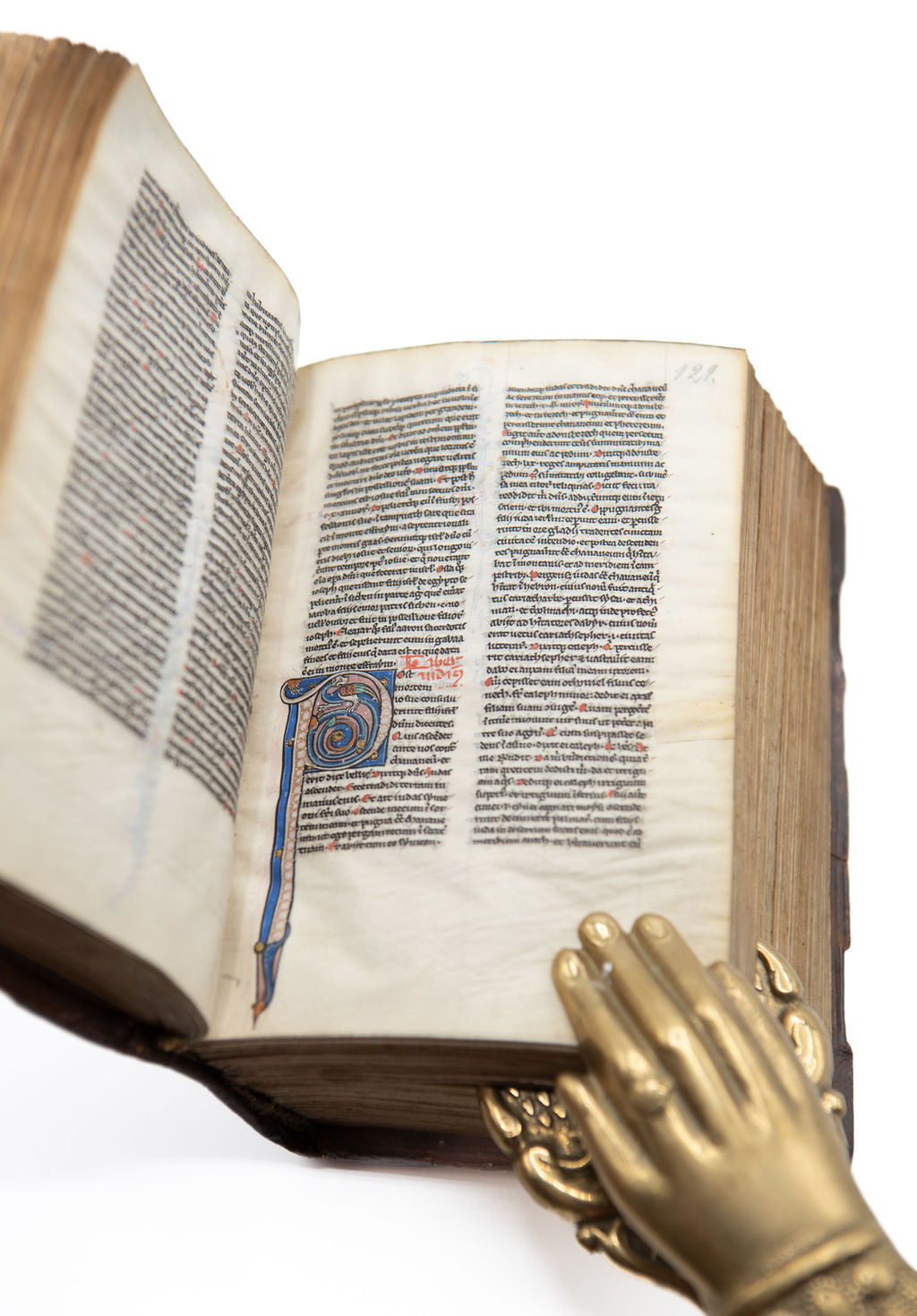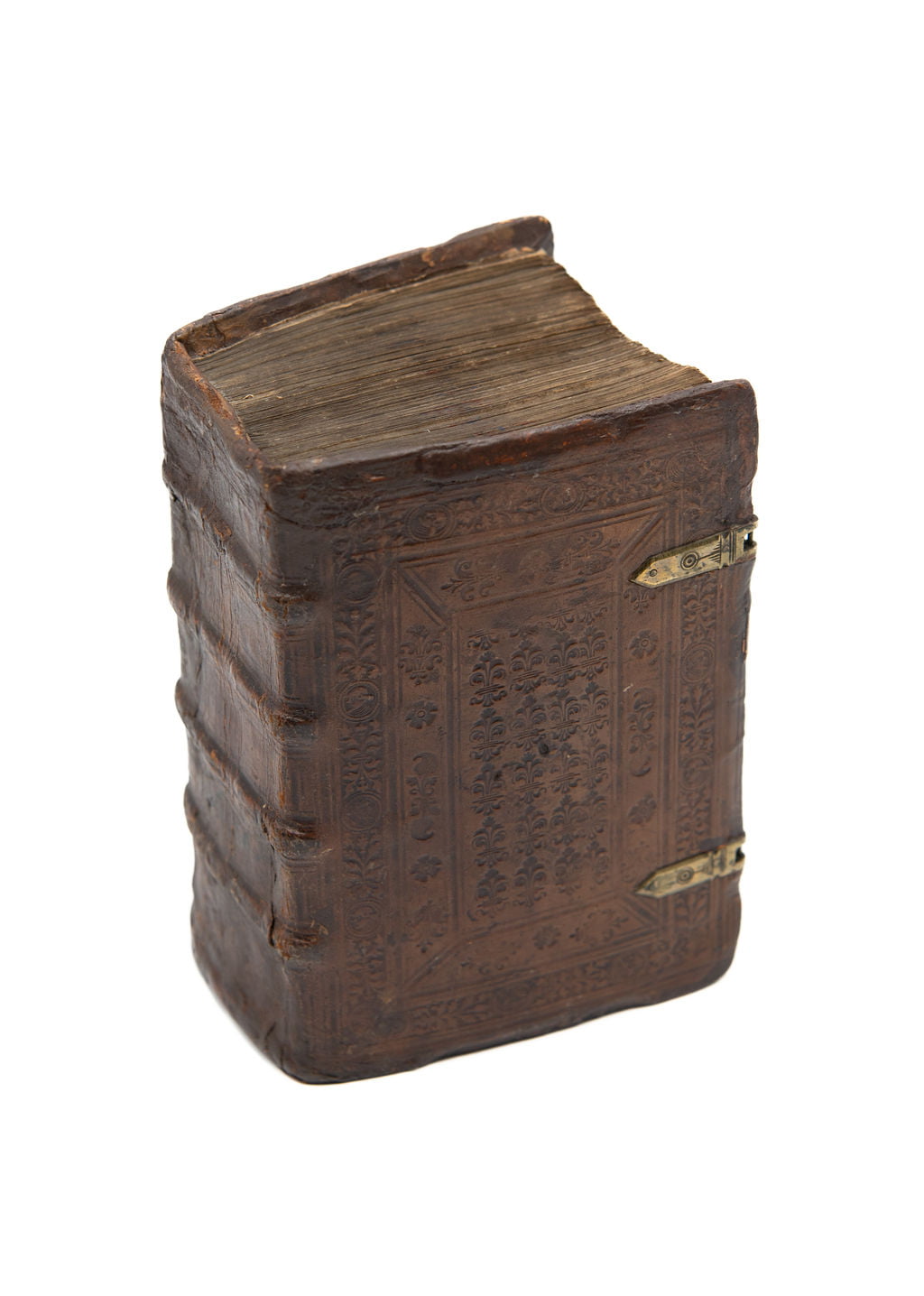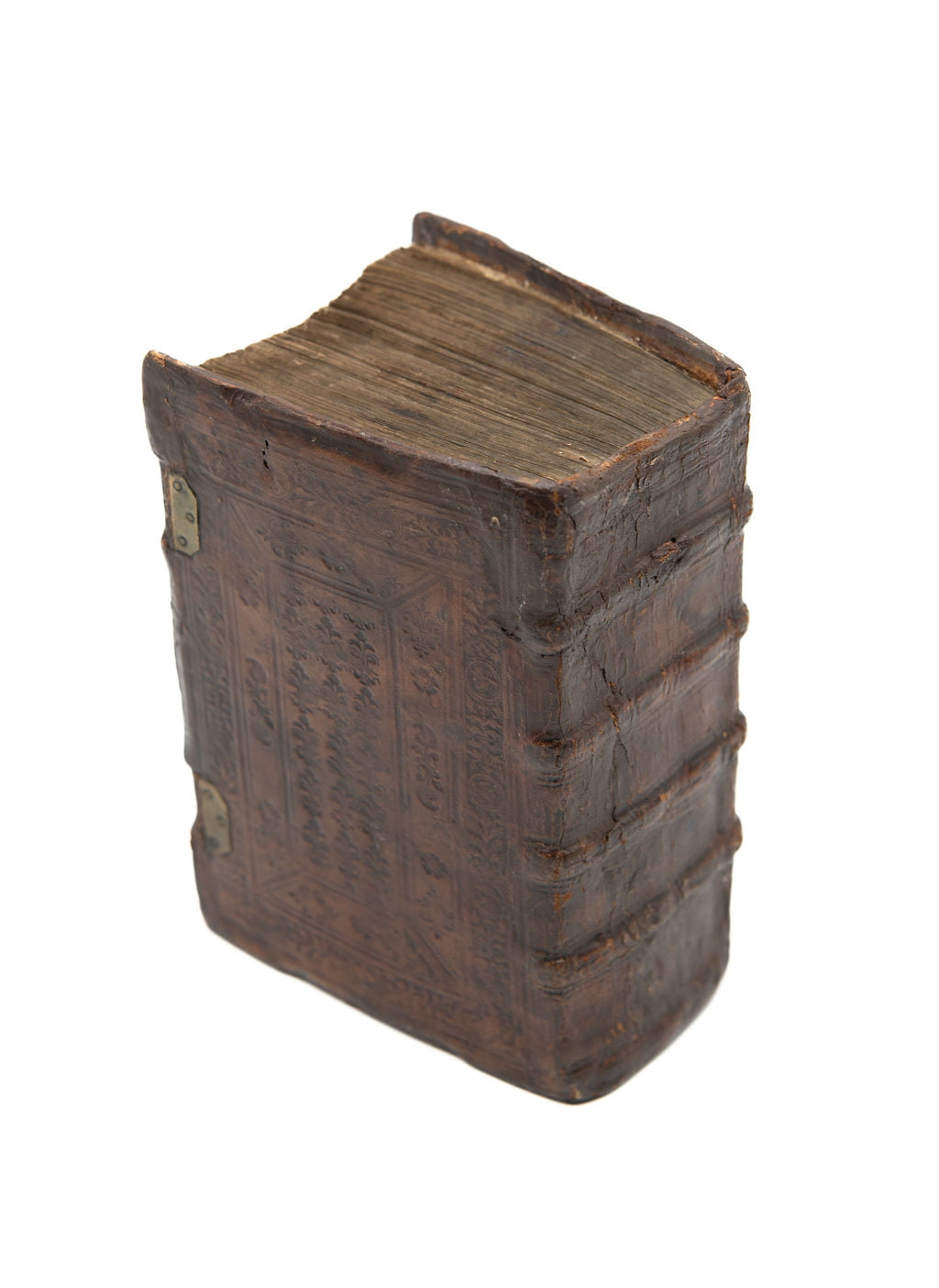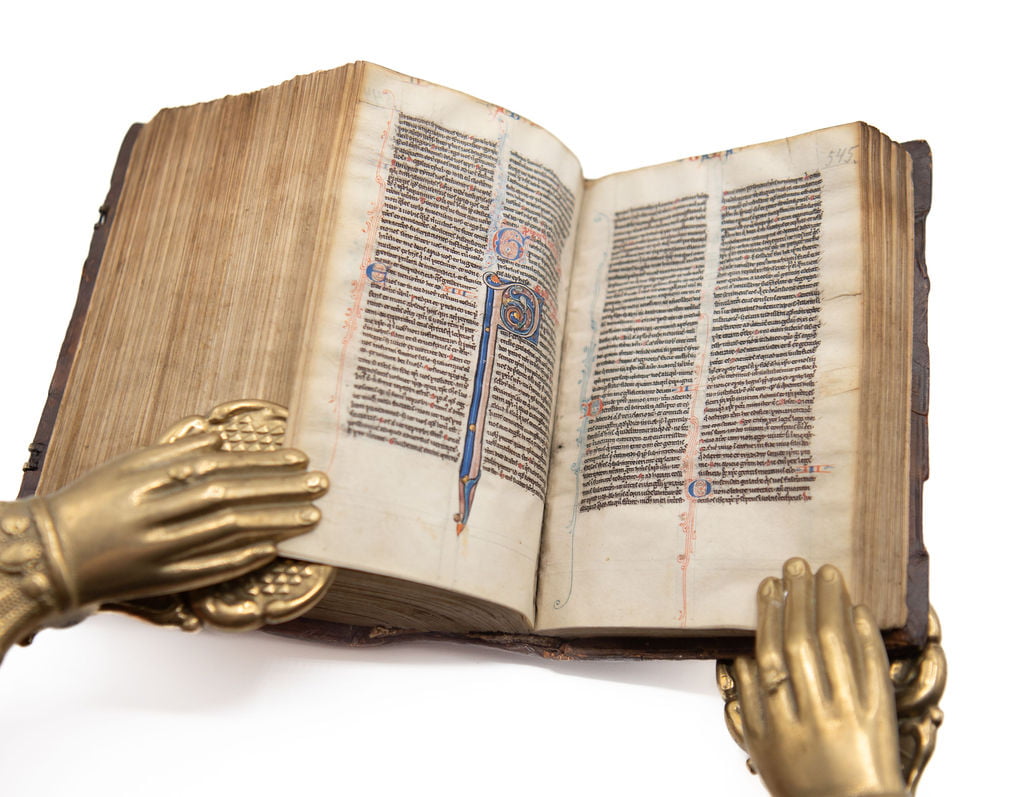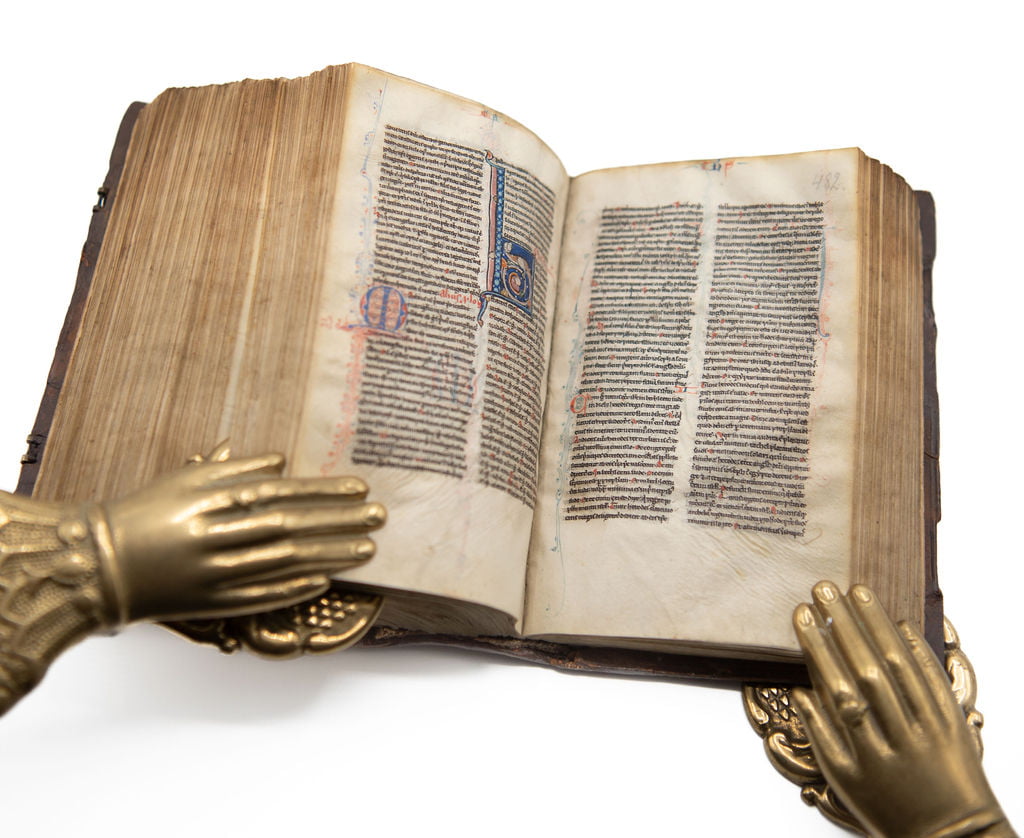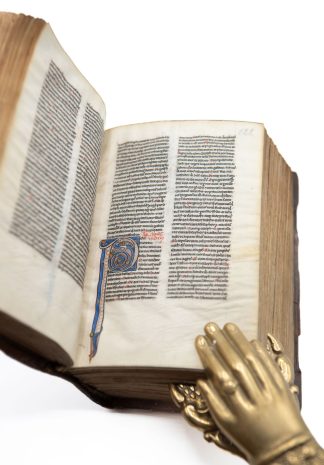BIBLE
COMPLETE PORTABLE PARISIAN BIBLE
Illuminated manuscript on vellum
France, Paris or Amiens, 13th century (2nd quarter)£150,000.00
146 x 95 mm, 656 leaves on parchment: I12, II-XII24, XIII26, XIV-XVII24, XVIII18, with no catchwords or leaf signatures; flyleaves at the beginning and end, the first and last used as pastedowns; modern foliation in pencil “1-655” repeating no. 521 (followed here). Justification 98 x 66/67 (30/31 x 5/6 x 30/31) mm ruled in lead point with two vertical bounding lines for two columns and 42 horizontal lines for 41 lines of text, with two extra horizontal lines; pricking holes for vertical bounders showing occasionally in the lower margins; two extra horizontal lines (3 mm apart) at circa 9-11 mm from upper ruled horizontal line and circa 15-19 mm from lower. Very small Gothic French bookhand (Textualis) deriving from glossing script, often called ‘pearl script’ (Perlschrift), in dark brown ink; less formal small Gothic hand influenced by documentary script for the added index of liturgical readings at end (fols. 653v-656v) (apparently unfinished); headings and highlighting of capitals in red, running-titles and chapter numbers in alternating red and blue capitals, versal initials in Psalms (fols 276r-303v) and Interpretationes (fols. 591r-653v; capitals not executed and dedicated space left blank from letter E onwards), chapter initials (2-15 lines high) in alternating red and blue with contrasting pen-flourished decoration throughout, 66 large puzzle initials (3-39 lines high, mostly 4-6 lines) in red and blue with pen-flourished decoration in red or red and blue, 78 large illuminated initials (from 3-line to column high, mostly 7-9 lines), in designs of spiralling foliage, occasionally inhabited by small dragons or other grotesque animals, in colours (blue, red, pink, green and white) and shell-gold. A few marginal 15th-century notes in light brown ink (see fols 248v, 425r and 425v, the latter by a Northern continental hand) and manicula in red (fol. 144v). Parchment (?) tabs marking the beginning of books removed. Thin parchment of good quality, with slight cockling, and a short cut at the fore-edge of some leaves caused by the removal of parchment tabs marking the beginning of books. Running titles occasionally cropped by the binder. C. 1500 binding, probably Flemish, light brown calf over bevelled wooden boards, sewn on four raised double-split spine bands, covers tooled in blind to a panel design, outer panel filled with a blind tooled heads-in-medallion roll, second panel with blind fleuron, rosette and leaves tools, and central panel semé with blind-tooled fleurons, with two long decorated brass catches at fore-edge of upper cover, and two stubs of calf-leather straps for fastening clasps (missing) secured at fore-edge of lower cover by two brass plaquettes; spine, edges and corners restored. 18th-century shelf marks on verso of third upper flyleaf and corner of lower pastedown; 19th century shelf mark “105/ 100_9 [or 1] i” in pencil at lower edge of upper pastedown. Preserved in wooden book box.
This charming and prettily decorated portable Bible is an untouched and unspoiled early example of the Parisian Bible of the 13th century. It was copied and decorated in the second quarter of the century, shortly after university theologians completed the standardization of the biblical texts. The new Vulgate had been created to facilitate university teachers and members of the preaching orders, who often travelled between universities, monasteries and church congregations in different parts of the country. It was therefore conceived as a text that could be copied in volumes of diminutive format, written on very fine parchment in the tiny formal Gothic script mostly used until then for marginal glosses. The new biblical vulgate started circulating in its final form about 1230. The present manuscript is therefore an early representative of the Parisian Vulgate. The text is complete and all the canonical prologues, each rubricated in full and decorated with an illuminated or a pen-flourished initial.
The initials are elegantly decorated with twirling rinceaux in colour and gold, and sometime include small dragons or other grotesque winged animals intertwined with the scrolling foliage. The puzzle initials, formed of interlocked scalloped segments in red and blue separated by a thin white line, are filled with curling pen-work decoration dotted in blue. A similarly curling and dotted decoration surrounds them and elongates into the margins in elegant pen strokes of red and blue. The style of the painted decoration resembles closely to works of the Parisian workshop known as the “Vie de saint Denis Atelier” (active 1230-1250) for the Benedictines of the Priory of Saint-Martin-des-Champs in Paris and the Cistercians of Clairvaux Abbey (see Paris, Bibliothèque nationale de france, MS latin 233). It also closely recalls the style of manuscripts produced at the same time in Amiens, Northern France for the Benedictine Abbeys of Anchin, and Marchiennes (see Douai, Bibliothèque Municipale, MSS 18, 20 and 21). The small codicological feature of parchment tabs marking the beginning of books, now removed from the present manuscript, adds a further link to manuscript Bibles produced at Amiens for monastic use (see R. Branner, Manuscript Paintings in Paris during the Reign of Saint Louis; a Study of Styles, Berkeley, 1977, cat. 210, pl. X).
In the 13th century the manuscript was used in a monastic or ecclesiastical institution as indicated by the index of liturgical readings added at the end of the volume by a 13th-century hand which was more used to writing monastic cartularies or ecclesiastical deeds than liturgical books. The prominence given to the feast of St Vincent of Saragossa (22 January) at the beginning of the readings for the Proper of the Saints, suggests a particular devotion to the saint. St Vincent is the patron saint of Macon and Viviers in France, Berne in Switzerland and Soignies in Belgium. A particular veneration for St Vincent and the probable Flemish origin of the fifteenth century binding combine to point to the collegiate church of St Vincent at Soignies as the probable 13th-century owner. St Vincent’s was built as the church of the Benedictine Abbey founded by St Vincent Madelgarius (d. 677), a Flemish nobleman. Soignies Abbey was dissolved and transformed in secular Chapter in the 11th century.
In the 17th century the book was in Prussia, in the possession of Johann Friedrich Bessel, a philologist of Tilsit, respondent and praeses at the Universities of Wittenberg and Helmstedt between 1654 and 1667. Left after Bessel’s death with others of his book to Christopher Horch Senior, possibly the father of the German physician Christopher Horch (1667-1754) of Berlin, it was given by Horch to an unidentifed individual on 13 February 1682 (“Hac Biblia manuscripta donata / mihi fuit à Dn. Christophero / Horch Sen. ex libris relictis / B. Dn. M. Besselj / Anno 1682 .d. 13 Febr.” on upper pastedown). The unnamed recipient of the book was probably either Heinrich Bartsch (1627-1702), councillor, treasurer and vice-mayor of Könisberg, who gave his collection to Könisberg Stadtbibliothek, or his son Heinrich Bartsch Jr (1667-1728), a jurist at the University of Wittenberg. In 1718 the library was opened to the public by Bartsch Junior, who donated his collection of Bibles.
In the 19th century the book was stamped “Stadtbibliothek Koenigsberg” twice in the lower margin of fol. 1 recto. The Bible is mentioned in the library catalogue A. Seraphim, Handschriften-Katalog der Stadtbibliothek Königsberg i.Pr., Königsberg i.Pr., 1909, p. 300. The library was destroyed by a bomb in August 1944. Since 1946 Königsberg has been part of Russia.
In stock


